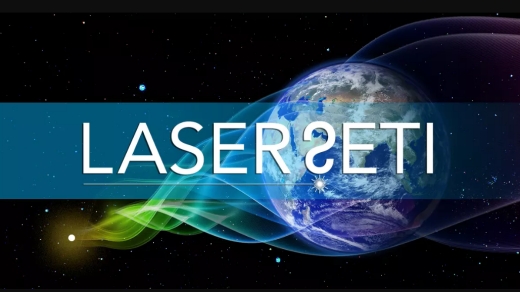Centauri Dreams
Imagining and Planning Interstellar Exploration
Keeping an Eye on Ross 128
Frank Elmore Ross (1874-1960), an American astronomer and physicist, became the successor to E. E. Barnard at Yerkes Observatory. Barnard, of course, is the discoverer of the high proper motion of the star named after him, alerting us to its proximity. And as his successor, Ross would go on to catalog over 1000 stars with high proper motion, many of them nearby. Ross 128, now making news for what observers at the Arecibo Observatory are calling “broadband quasi-periodic non-polarized pulses with very strong dispersion-like features,” is one of these, about 11 light years out in the direction of Virgo.
Any nearby stars are of interest from the standpoint of exoplanet investigations, though thus far we’ve yet to discover any companions around Ross 128. An M4V dwarf, Ross 128 has about 15 percent of the Sun’s mass. More significantly, it is an active flare star, capable of unpredictable changes in luminosity over short periods. Which leads me back to that unusual reception. The SETI Institute’s Seth Shostak described it this way in a post:
What the Puerto Rican astronomers found when the data were analyzed was a wide-band radio signal. This signal not only repeated with time, but also slid down the radio dial, somewhat like a trombone going from a higher note to a lower one.
And as Shostak goes on to say, “That was odd, indeed.”
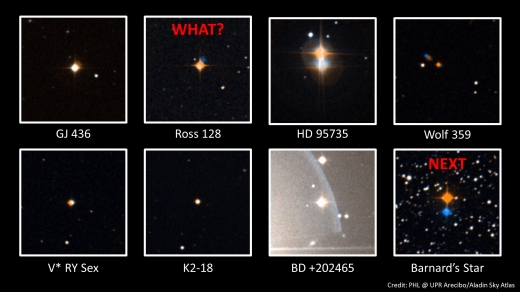
It’s this star’s flare activity that stands out for me as I look over the online announcement of its unusual emissions, which were noted during a ten-minute spectral observation at Arecibo on May 12. Indeed, Abel Mendez, director of the Planetary Habitability Laboratory at Arecibo, cited Type II solar flares first in a list of possible explanations, though his post goes on to note that such flares tend to occur at lower frequencies. An additional novelty is that the dispersion of the signal points to a more distant source, or perhaps to unusual features in the star’s atmosphere. All of this leaves a lot of room for investigation.
We also have to add possible radio frequency interference (RFI) into the mix, something the scientists at Arecibo are examining as observations continue. The possibility that we are dealing with a new category of M-dwarf flare is intriguing and would have obvious ramifications given the high astrobiological interest now being shown in these dim red stars.
Picture of the star field around #Ross128 (near center) that I generated from @AAVSO for @EliBonora pic.twitter.com/RbWBW7EmXl
— Prof. Abel Méndez (@ProfAbelMendez) July 19, 2017
All of this needs to be weighed as we leave the SETI implications open. The Arecibo post notes that signals from another civilization are “at the bottom of many other better explanations,” as well they should be assuming those explanations pan out. But we should also keep our options open, which is why the news that the Breakthrough Listen initiative has now observed Ross 128 with the Green Bank radio telescope in West Virginia is encouraging.
No evidence of the emissions Arecibo detected has turned up in the Breakthrough Listen data. We’re waiting for follow-up observations from Arecibo, which re-examined the star on the 16th, and Mendez in an update noted that the SETI Institute’s Allen Telescope Array had also begun observations. Seth Shostak tells us that the ATA has thus far collected more than 10 hours of data, observations which may help us determine whether the signal has indeed come from Ross 128 or has another source.
“We need to get all the data from the other partner observatories to put all things together for a conclusion,” writes Mendez. “Probably by the end of this week.”
Or perhaps not, given the difficulty of detecting the faint signal and the uncertainties involved in characterizing it. If you’re intrigued, an Arecibo survey asking for public reactions to the reception is now available.
I also want to point out that Arecibo Observatory is working on a new campaign to observe stars like Ross 128, the idea being to characterize their magnetic environment and radiation. One possible outcome of work like that is to detect perturbations in their emissions that could point to planets — planetary magnetic fields could conceivably affect flare activity. That’s an intriguing way to look for exoplanets, and the list being observed includes Barnard’s Star, Gliese 436, Ross 128, Wolf 359, HD 95735, BD +202465, V* RY Sex, and K2-18.
A final note: Arecibo is now working with the Red Dots campaign in coordination with other observatories to study Barnard’s Star, for which there is some evidence of a super-Earth mass planet. More on these observations can be found in this Arecibo news release.

Making Optical SETI Happen
Yesterday I made mention of the Schwartz and Townes paper “Interstellar and Interplanetary Communication by Optical Masers,” which ran in Nature in 1961 (Vol. 190, Issue 4772, pp. 205-208). Whereas the famous Cocconi and Morrison paper that kicked off radio SETI quickly spawned an active search in the form of Project Ozma, optical SETI was much slower to develop. The first search I can find is a Russian project called MANIA, in the hands of V. F. Shvartsman and G. M. Beskin, who searched about 100 objects in the early 1970s, finding no significant brightness variations within the parameters of their search.

If you want to track this one down, you’ll need a good academic library, as it appears in the conference proceedings for the Third Decennial US-USSR Conference on SETI, published in 1993. Another Shvartsman investigation under the MANIA rubric occurred in 1978. Optical SETI did not seem to seize the public’s imagination, perhaps partially because of the novelty of communications through the recently discovered laser. We do see several optical SETI studies at UC-Berkeley’s Leuschner Observatory and Kitt Peak from 1979 to 1981, the work of Francisco Valdes and Robert Freitas, though these were searches for Bracewell probes within the Solar System rather than attempts to pick up laser transmissions from other star systems.
Image: Harvard’s Paul Horowitz, a key player in the development of optical SETI. Credit: Harvard University.
This was an era when radio searches for extraterrestrial technology had begun to proliferate, but despite the advocacy of Townes and others (and three conferences Townes helped create), it wasn’t until the 1990s that optical SETI began to come into its own. Charles Townes himself was involved in a search for laser signals from about 300 nearby stars in the ’90s, using the 1.7-meter telescope on Mt. Wilson and reported on at the 1993 conference. Stuart Kingsley began an optical SETI search using the 25-centimeter telescope at the Columbus Optical SETI Observatory (COSETI) in 1990, while Gregory Beskin searched for optical signals at the Special Astrophysical Observatory run by the Russian Academy of Sciences in the Caucasus in 1995.
Optical SETI’s advantages were beginning to be realized, as Andrew Howard (Caltech) commented in a 2004 paper:
The rapid development of laser technology since that time—a Moore’s law doubling of capability roughly every year—along with the discovery of many microwave lines of astronomical interest, have lessened somewhat the allure of hydrogen-line SETI. Indeed, on Earth the exploitation of photonics has revolutionized communications technology, with high-capacity fibers replacing both the historical copper cables and the long-haul microwave repeater chains. In addition, the elucidation (Cordes & Lazio 1991) of the consequences to SETI of interstellar dispersion (first seen in pulsar observations) has broadened thinking about optimum wavelengths. Even operating under the prevailing criterion of minimum energy per bit transmitted, one is driven upward to millimetric wavelengths.

In the late 90’s, the SETI Institute, as part of a reevaluation of SETI methods, recommended and then co-funded several optical searches including one by Dan Werthimer and colleagues at UC Berkeley and another by a Harvard-Smithsonian team including Paul Horowitz and Andrew Howard. The Harvard-Smithsonian group also worked in conjunction with Princeton University on a detector system similar to the one mounted on Harvard’s 155-centimeter optical telescope. A newer All-Sky Optical SETI (OSETI) telescope, set up at the Oak Ridge Observatory at Harvard and funded by The Planetary Society, dates from 2006.
Image: Dan Werthimer, chief scientist at the Berkeley SETI Research Center. Credit: UC-Berkeley.
At Berkeley, the optical SETI effort is led by Werthimer, who had built the laser detector for the Harvard-Smithsonian team. Optical SETI efforts from Leuschner Observatory and Lick Observatory were underway by 1999. Collaborating with Shelley Wright (UC Santa Cruz), Remington Stone (UC Santa Cruz/Lick Observatory), and Frank Drake (SETI Institute), the Berkeley group has gone on to develop new detector systems to improve sensitivity. As I mentioned yesterday, UC-Berkeley’s Nate Tellis, working with Geoff Marcy, has analyzed Keck archival data for 5,600 stars between 2004 and 2016 in search of optical signals.
Working in the infrared, the Near-Infrared Optical SETI instrument (NIROSETI) is designed to conduct searches at infrared wavelengths. Shelley Wright is the principal investigator for NIROSETI, which is mounted on the Nickel 1-meter telescope at Lick Observatory, seeing first light in March of 2015. The project is designed to search for nanosecond pulses in the near-infrared, with a goal “to search not only for transient phenomena from technological activity, but also from natural objects that might produce very short time scale pulses from transient sources.” The advantage of near-infrared is the decrease in interstellar extinction, the absorption by dust and gas that can sharply impact the strength of a signal.
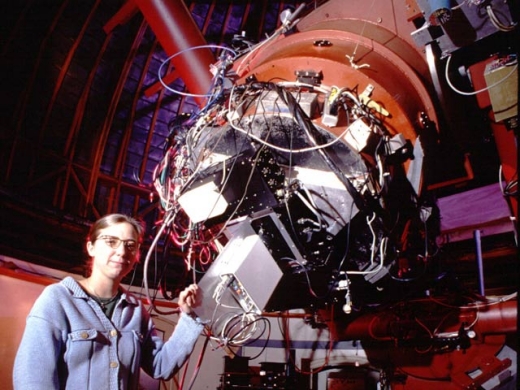
Image: Shelley Wright, then a student at UC-Santa Cruz, helped build a detector that divides the light beam from a telescope into three parts, rather than just two, and sends it to three photomultiplier tubes. This arrangement greatly reduces the number of false alarms; very rarely will instrumental noise trigger all three detectors at once. The three-tube detector is in the white box attached here to the back of the 1-meter Nickel Telescope at Lick Observatory. Credit: Seth Shostak.
I might also mention METI International’s Optical SETI Observatory at Boquete, Panama. The idea is to put the optical SETI effort in context. With the SETI Institute now raising money for its Laser SETI initiative — all-sky all-the-time — the role of private funding in making optical SETI happen is abundantly clear. And now, of course, we also have Breakthrough Listen, which in addition to listening at radio wavelengths at the Parkes instrument in Australia and the Green Bank radio telescope in West Virginia, is using the Automated Planet Finder at Lick Observatory to search for optical laser transmissions. Funded by the Breakthrough Prize Foundation, the project continues the tradition of private funding from individuals, institutions (the SETI Institute) and organizations like The Planetary Society to get optical SETI done.

Detection Possibilities for Optical SETI
The Laser SETI campaign we looked at on Friday is one aspect of a search for intelligent life in the universe that is being addressed in many ways. In addition to optical methods, we look of course at radio wavelengths, and as we begin to characterize the atmospheres of rocky exoplanets, we’ll also look for signs of atmospheric modification that could indicate industrial activity. But we have to be careful. Because SETI looks for evidence of alien technology, it is a search for civilizations about whose possible activities we know absolutely nothing.
So we can’t make assumptions that might blind us to a detection. Getting the blinders off also means extending our reach. If successful, the Laser SETI project will do two things we haven’t been able to do before — it will scan the entire sky and, because it is always on, it will catch optical transients we are missing today, and tell us whether any of these are repeating.
In radio terms, think of the famous WOW! signal of 1977, detected at Ohio State University’s Big Ear radio telescope. Seeming to come out of the constellation Sagittarius, it fit our ideas of what an extraterrestrial signal could look like, but we can’t draw any conclusions because we’ve never seen it again. If the signal intrigues you, Robert Gray’s book The Elusive WOW (Palmer Square, 2011) goes into it in great depth, including Gray’s 1987 and 1989 attempts to find it. Gray would search again in the mid 90’s using the Very Large Array, and again in 1999 with the University of Tasmania’s Mount Pleasant Radio Observatory, with null results.
The Elusive WOW is a splendid page-turner that captures the drama of the hunt. It also reminds us how frustrating a transient can be — here today, gone in moments, never seen again. Did the WOW signal reappear at some time that we weren’t pointing our instruments at it? Is it repeating on some schedule we haven’t figured out?

All-sky surveys like Laser SETI weren’t on the mind of Giuseppe Cocconi and Philip Morrison when they wrote their ground-breaking paper “Searching for Interstellar Communications” in Nature (1959), one that is mostly commonly cited as launching SETI. But for optical SETI’s origins, we can look back with equal admiration at R. N. Schwartz and Charles Townes’ “Interstellar and Interplanetary Communication by Optical Masers,” which ran two years later in the same journal. The author’s vision encapsulates the idea:
We propose to examine the possibility of broadcasting an optical beam from a planet associated with a star some few or some tens of light-years away at sufficient power-levels to establish communications with the Earth. There is some chance that such broadcasts from another society approximately as advanced as we are could be adequately detected by present telescopes and spectrographs, and appropriate techniques now available for detection will be discussed. Communication between planets within our own stellar system by beams from optical masers appears a fortiori quite practical.
Image: Charles Hard Townes, at the National Institute of Biomedical Imaging and Bioengineering’s 5th Anniversary Symposium, held in June 2007. Credit: NIBIB.
Optical SETI Scenarios
We saw Friday that a petawatt laser of the kind that has been built at Lawrence Livermore National Laboratory could be transformed into an optical SETI beacon, working in conjunction with a huge mirror like that found on our largest telescopes. Indeed, the Sun can be outshone by a factor of 10,000, a bright and, one would assume, obviously artificial beacon. But the complexities involved in targeting another star — and aiming the beam to lead the moving target, one that will be many light years away, make targeted laser beacons difficult.
Surely the challenges of laser beacons — not to mention their cost — could be overcome by advanced civilizations, although the idea of a less targeted beacon seems to make more sense; i.e., a beacon that sweeps a region of the sky on a recurrent basis, assuming the intent here is simply to announce the presence of the extraterrestrial civilization as widely as possible. But perhaps it’s much more likely that, if we do detect a laser signal from another civilization, it will be in the form of a chance interception of a technology at work.
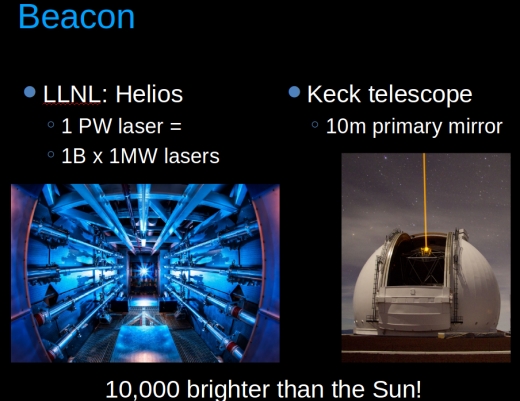
Image: The power of laser technology even today. Credit: Eliot Gillum/SETI Institute.
Detecting communications within an exoplanetary system presents serious problems of geometry, given that these optical beams would be broadcast to specific targets and are unlikely to be pointing by chance at the Earth. But there is a scenario that could work: We’ve learned all about exoplanet detection through planetary transits from the Kepler mission. A planetary system that was co-planar with our own could produce a communications beam between its own planets that swept past us with each orbital revolution. Even then, the target planet would likely absorb enough of the signal that detection would be unlikely.
But there are other kinds of detections. James Guillochon and Abraham Loeb have looked at the possibility that beaming to interstellar sailcraft would produce leakage that might be observable to our detectors (see SETI via Leakage from Light Sails in Exoplanetary Systems). Both interplanetary as well as interstellar transportation systems leave possible signatures.
And consider Boyajian’s Star (KIC 8462852), whose odd light curves drew it to the attention of citizen scientists at the Planet Hunters project and subsequent worldwide scrutiny. Numerous natural phenomena have been put forward to explain what we are seeing here, but light curves like this could also be the sign of an extraterrestrial civilization working on some kind of massive project (a Dyson sphere inevitably comes to mind, but who knows?)
It made sense, then, to make Boyajian’s Star a SETI target, which is why the SETI Institute used the Allen Telescope Array to search for radio emissions, a two-week survey that produced no evidence of artificial radio signals coming from the system. For more on this investigation, see Jim and Dominic Benford’s Quantifying KIC 8462852 Power Beaming, which analyzed the ATA results at radio wavelengths. But note the following, which summarizes what the Benfords believe would be detectable given the instruments used in the attempt. As you can see, not all detectable signals would come from power beamed, for example, to an interstellar mission. Some of them definitely include applications within the target system:
- Orbit raising missions, which require lower power, are not detectable at the thresholds of the Allen Array.
- Launch from a planetary surface into orbits would be bright enough to be seen by the 100 kHz observations. However, the narrow bandwidth 1 Hz survey would not see them.
- Interplanetary transfers by beam-driven sails should be detectable in their observations, but are not seen. This is for both the narrow 1 Hz and for the “wideband” 100 kHz observations.
- Starships launched by power beams with beamwidths that we happen to fall within would be detectable, but are not seen.
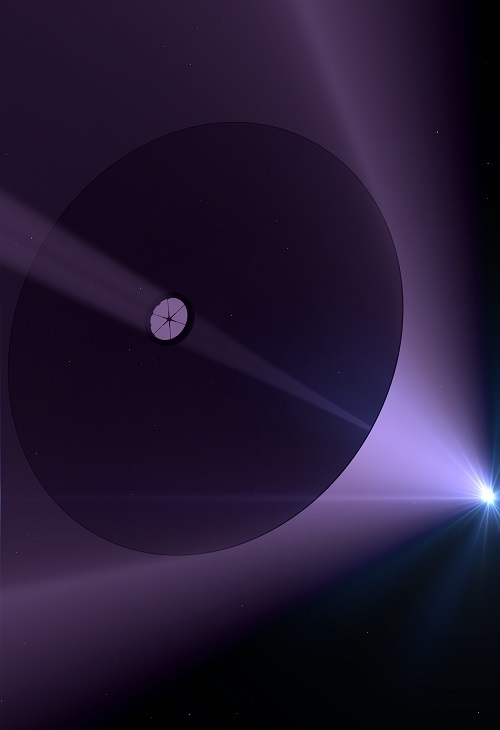
Image: Power beaming to drive an interstellar lightsail. Credit: Adrian Mann.
But let’s move back into the optical. Nate Tellis (UC-Berkeley) recently worked with astronomer Geoff Marcy to analyze Keck data archives on 5,600 stars observed between 2004 and 2016, using a computer algorithm fine-tuned to detect laser light (see A Search for Laser Emission with Megawatt Thresholds from 5600 FGKM Stars,” preprint here). The search was an excellent way to put thousands of hours of accumulated astronomical data to work — who knows what discoveries may lurk within such datasets? As a part of the effort, the astronomers studied Boyajian’s Star, again finding no detectable signals. Potential candidates that did emerge in the survey all turned out to be the result of natural processes.
But power beaming is a possible observable as any local civilization goes about moving things around in its own system. Leakage from a beamed power infrastructure is something we’ve focused on here frequently (see, for example, Power Beaming Parameters & SETI re KIC 8462852). Power beaming could be what enables a space-based infrastructure, one that would be capable of large-scale engineering and also of producing the kind of power beams that could drive spacecraft at high velocity to other stars.
But we needn’t exclude communications entirely. Jim Benford has pointed out that any civilization using large-scale power beaming would be aware that its activities could be visible to others. If it had the desire to communicate on such a random basis, the ETI civilization could embed a message within the beam. A kind of interstellar message in a bottle, thrown into the cosmic sea with each sweeping power beam that does local work.
All of this should reinforce the key issue that the Laser SETI project addresses — such beams, working within their own planetary system, would appear in our sky as transients. We return to the core issue, the need for an all-sky survey that observes continuously. Making no assumptions about any desire to communicate, such a survey nonetheless is capable of spotting the signs of a working civilization going about its business. It should, I would wager, also pick out new astrophysical phenomena that will add to our knowledge of the galaxy.

Laser SETI: All Sky All the Time
The SETI Institute’s just announced Laser SETI funding campaign intends to put into practice what SETI researchers have been anticipating for decades, an all-sky, all-the-time observing campaign. The Institute’s Eliot Gillum and Gerry Harp are behind the project, backed by an impressive list of advisors, with the intention of using optical SETI methods to look for signs of extraterrestrial civilizations. In doing so, they’re reminding us how we’ve done SETI, how we can surmount its current limitations, and what a SETI of the future will look like.
Think about how SETI has evolved since the days when Frank Drake created Project Ozma at the National Radio Astronomy Observatory at Green Bank (WV). Fresh with the insights of Giuseppe Cocconi and Philip Morrison, who examined radio methods and suggested a search for signals near the 21 centimeter wavelength of neutral hydrogen, Drake turned a 26-meter radio telescope to examine the nearby Sun-like stars Tau Ceti and Epsilon Eridani.
Would SETI be a matter of looking at specific stars at certain wavelengths? Immediately the list of questions began to grow. Once you have chosen a target (and there are 18 million stars within 1000 light years), how long do you need to examine it before moving on to another? For that matter, are radio wavelengths optimal? And if our method is to look at particular places at particular times, how would we detect periodic signals that are on no schedule we can hope to predict? What do we miss in between?
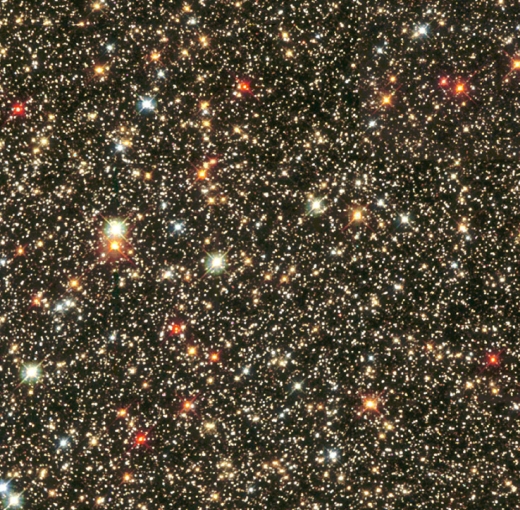
Image: The view toward Messier 24, the Sagittarius star cloud. We are looking for signals amidst immensity. Credit: Hubble Heritage Team (AURA/ STScI/ NASA).
All Sky All the Time
We started doing SETI at radio wavelengths at a time when there were no operational lasers, but today we can look at the experience of our own civilization to see how high-capacity fibers have changed the way we communicate. As we add laser methods to SETI, we begin looking for the kind of monochromatic optical signal that nature does not tend to produce. We also look on timescales of nanoseconds, for no natural sources produce nanosecond pulses.
Configured to serve as a beacon, the Helios laser at Lawrence Livermore National Laboratory could outshine our own Sun by a factor of 10,000. Couldn’t an ET civilization do the same?
But of course we have no way of making assumptions about what an alien civilization might do. We may not receive a beacon at all. We may find ourselves intercepting alien communications or activities like power beaming that produce optical signatures but are not intended as communications. For that matter, here on Earth we use powerful radars (think Arecibo) to examine near-Earth asteroids as we assess impact possibilities. The beams from these searches should be detectable, but would appear in an alien sky as a transient.
So we have to get away from the assumption that any extraterrestrial civilization will be ‘always on,’ just waiting for us to detect it. Searching with instruments pointed at specific targets and limited by short ‘dwell’ times (how long we remain on that target), we wouldn’t find the great bulk of transients that could be telltale evidence of other civilizations. We’re just now learning, for example, about Fast Radio Bursts (FRBs), millisecond radio pulses thought to occur in their thousands every day and still poorly understood. Because they appear as transients, we’ve only catalogued a handful. SETI sometimes detects radio transients that never, to our knowledge, reoccur. Or perhaps some do, but we aren’t looking then.
Current methods are, to use Paul Shuch’s phrase, looking at the sky through a soda straw. Laser SETI proposes to put an end to that limitation with new detectors that will become the basis of observatories that will one day provide global coverage of the entire sky.
Moreover, the detector Eliot Gillum talked about in last year’s Breakthrough Discuss meeting, is not hypothetical. The design has been turned into a prototype and tested with sky observations to validate the methods and analyze performance. The Laser SETI campaign on Indiegogo seeks to raise the funds needed to produce a minimum of two cameras, enough to localize targets on the sky and examine the algorithms used in signal detection.
Pushing Imaging Technologies in SETI’s Direction
Laser SETI’s technology involves cameras with a wide field of view that use ‘drift scanning’ methods (a fixed camera tracking the celestial scene as it passes above). The camera is a charged coupled device (CCD), a familiar technology widely used not only in astronomical observations but also in cell phone cameras and numerous scientific applications. Photons striking a CCD’s light-sensitive elements generate a charge that can be read by electronics within the device and turned into a digital copy of the light falling onto the surface.
But that just begins the story. Remember, we’re talking about the night sky moving across the camera’s fixed field of view. Laser SETI thus incorporates what is called Time-Delay Integration (TDI), a CCD readout technique used in many applications to capture images of fast-moving objects. TDI can preserve both sensitivity and image quality even when dealing with fast relative movement, with photo-charges constantly being shifted down the CCD detector from pixel to pixel as they record changes to the light pattern being observed.
In TDI work as it is normally used — this might be, for example, in factories for quality control — the shift rate within the CCD matches the rate of the target being imaged. But Laser SETI’s new technology uses TDI in an entirely novel way. Instead of producing a normal working image, the idea is to overclock the TDI so that the ‘scene’ — the sky above — becomes smeared out and spread over the entire CCD. The beauty of this is that while the background sky loses definition, any transient pulses that appear show up as a single point.
Reading out the camera at over 1000 times per second, the detector also employs a transmission grating that spreads each point source into two spectra, allowing a single color of light to be distinguished from other kinds of sources. Gillum and Harp’s methods demand two cameras, the second looking at the same field of view but turned 90 degrees sideways. The coordination between the two instruments allows the software to recover accurate sky coordinates for any transient being observed. Putting four cameras at a given site, coupled the same way (two per field of view), allows the entire night sky to be covered.
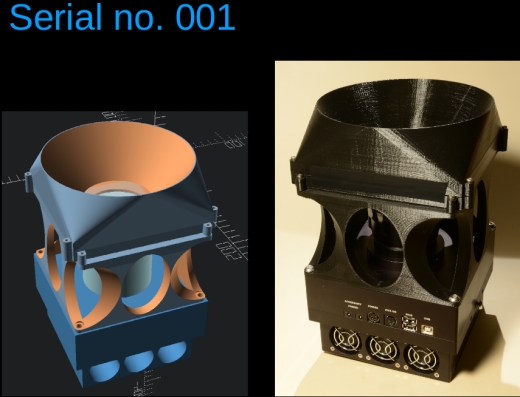
Image: The first detector. The CCD camera is at the base, the lens atop it, and the transmission grating at the top beneath the hood. Two of the major three components here are off-the-shelf, keeping costs low. Credit: SETI Institute/Eliot Gillum.
Moving Laser SETI Worldwide
You can see what all this is building toward. The Indiegogo project’s intent is to raise the money for two cameras, but further funding takes us toward multiple site operations. The entire sky can’t be seen from any one part of the globe, but six observatories could cover all of it, with eventual secondary observatories adding valuable statistical validation, and also necessary sky coverage during times when the weather is inclement at any one site.
Have a look at the Laser SETI campaign for further background. The low cost of these detectors is significant. And bear this in mind. When we look at particular points in the sky, we have to be lucky enough that the signal we seek is available just then, just there. Looking everywhere all the time, we see the brightest signals in the sky whenever they appear.
In the entire history of radio astronomy, it has taken us until now to detect Fast Radio Bursts. What else are we missing? As Eliot Gillum pointed out in a recent presentation, we have no way of knowing what any extraterrestrial civilization may be doing, but we can say this: If their activity is bright but intermittent, all previous and current searches very likely won’t find it.
That’s why we need to look at the entire sky all the time.

Citizen Scientist Imagery of the Great Red Spot
All of the Juno spacecraft’s instruments — including JunoCam — were operational during its July 10 flyby, giving us a close-up look at the Great Red Spot. Now 16,000 kilometers wide, the storm has been studied since 1830 and may be considerably older than that. Juno’s orbit took it to perijove (closest to Jupiter’s center) at 2155 EDT on the 10th (0155 UTC on the 11th), when it closed to about 3500 kilometers above the cloud tops. The passage across the Great Red Spot occurred eleven minutes later at some 9000 kilometers above the clouds.
While the data are being unpacked and analyzed, we can enjoy the efforts of citizen scientists who went to work on the raw images posted on the JunoCam site and processed them, a procedure done in coordination with the Juno team.
“These highly-anticipated images of Jupiter’s Great Red Spot are the ‘perfect storm’ of art and science. With data from Voyager, Galileo, New Horizons, Hubble and now Juno, we have a better understanding of the composition and evolution of this iconic feature,” said Jim Green, NASA’s director of planetary science. “We are pleased to share the beauty and excitement of space science with everyone.”
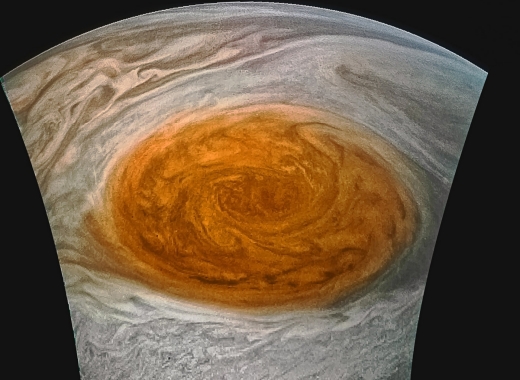
Image: This enhanced-color image of Jupiter’s Great Red Spot was created by citizen scientist Jason Major using data from the JunoCam imager on NASA’s Juno spacecraft. The image was taken on July 10, 2017 at 07:10 p.m. PDT (10:10 p.m. EDT), as the Juno spacecraft performed its 7th close flyby of Jupiter. At the time the image was taken, the spacecraft was about 13,917 kilometers from the tops of the clouds of the planet. Credit: NASA/JPL-Caltech/SwRI/MSSS/Jason Major.
And let’s go through the two others just posted by JPL.The one below was created by Kevin Gill, likewise working with raw data from the JunoCam imager.
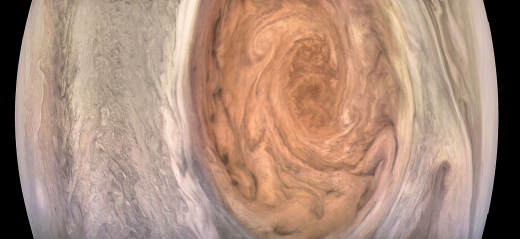
And a final image from citizen scientist Gerald Eichstädt.
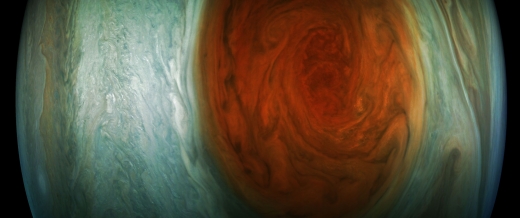
The English natural philosopher Robert Hooke (1635-1703) described what may have been the Great Red Spot in 1664, although he seems to have placed it on the wrong side of the Jovian equator, making the sighting problematic. The following year, however, Giovanni Cassini detected a ‘permanent storm’ that remained under observation into the 18th Century, although there are no observations between 1713 and 1830. The first certain record of the Great Red Spot occurs in an 1831 drawing by German amateur Samuel Heinrich Schwabe.
The red coloration of the Great Red Spot is problematic, with suggestions ranging from compounds of sulfur and phosphorus to organic material produced by high-altitude photochemical reactions or lightning discharges. The Voyager spacecraft returned spectacular imagery, including the Voyager 1 image in 1979 shown below, which revealed details as small as 160 kilometers and highlighted the spectacularly complex wave motion west of the Spot.
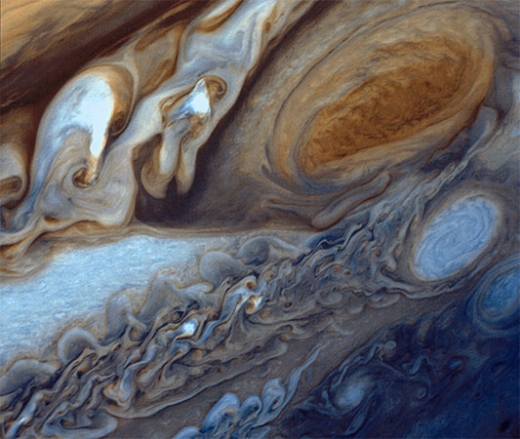
Image: Jupiter’s Great Red Spot (top right) and the surrounding region, as seen from Voyager 1 on March 1, 1979. Below the spot is one of the large white ovals associated with the feature. NASA/JPL
Since the Voyager encounters (and indeed, since the late 19th Century) the Spot has been shrinking. Voyager measured its length at 23,000 kilometers, and since 2012 it has been diminishing at a rate of about 900 kilometers per year. We’ll see what Juno can tell us about the giant storm’s energy source and its longevity as data are processed in the weeks ahead.

A Binary ‘Rogue’ Planet?
‘Planetary mass binary’ is an unusual term, but one that seems to fit new observations of what was thought to be a brown dwarf or free-floating large Jupiter analog, and now turns out to be two objects, each of about 3.7 Jupiter masses. That puts them into planet-range when it comes to mass, as the International Astronomical Union normally considers objects below the minimum mass to fuse deuterium (13 Jupiter masses) to be planets. This is the lowest mass binary yet discovered.
A team led by William Best (Institute for Astronomy, University of Hawaii) went to work on the L7 dwarf 2MASS J11193254–1137466 with the idea of determining what they assumed to be the single object’s mass and age. It was through observations with the Keck II telescope in Hawaii that they discovered the binary nature of their target. The separation between the two objects is about 3.9 AU, based upon the assumption that the binary is around 160 light years away, the distance of the grouping of stars called the TW Hydrae Association.
Let’s pause on this for a moment. The TW Hydrae Association has come up in these pages in the past, as a so-called ‘moving group’ that contains stars that share a common origin, and thus are similar in age and travel through space together. Moving groups are obviously useful — if astronomers can determine that a star is in one, then its age and distance can be inferred from the other stars in the group. Best and colleagues determined from key factors like sky position, proper motion, and radial velocity that there was about an 80 percent chance that 2MASS J11193254–1137466AB is a member of the TW Hydrae Association.

Image: Keck images of 2MASS J11193254–1137466 reveal that this object is actually a binary system. A similar image of another dwarf, WISEA J1147-2040, is shown at bottom left for contrast: this one does not show signs of being a binary at this resolution. Credit: Best et al. 2017.
Determining a brown dwarf’s age is tricky business because these objects cool continuously as they age, which means that brown dwarfs of different masses and ages can wind up with the same luminosity. The authors point out that this mass-age-luminosity degeneracy makes it hard to figure out their characteristics without knowing at least two of the three parameters. Membership in a moving group like the TW Hydrae Association gives us an age of about 10 million years but also provides mass estimates from evolutionary models.
And a binary system hits the jackpot, for now we can study the orbits of the two objects to work out model-independent masses, which is how Best drilled down to the 3.7 Jupiter mass result for each binary member here. The authors consider the binary a benchmark for tests of evolutionary and atmospheric models of young planets, and go on to speculate about its possible origins:
The isolation of 2MASS J1119?1137AB strongly suggests that it is a product of normal star formation processes, which therefore must be capable of making binaries with ? 5 MJup components. 2MASS J1119?1137AB could be a fragment of a higher-order system that was ejected via dynamical interactions (Reipurth & Mikkola 2015), although the lack of any confirmed member of TWA within 10° (projected separation ? 5 pc) of 2MASS J1119?1137 makes this scenario unlikely. Formation of very low mass binaries in extended massive disks around Sun-like stars followed by ejection into the field has been proposed by, e.g., Stamatellos & Whitworth (2009), but disks of this type have not been observed.

Image: The positions of 2MASS J11193254–1137466A and B on a color-magnitude diagram for ultracool dwarfs. The binary components lie among the faintest and reddest planetary-mass L dwarfs. Credit: Best et al. 2017.
So there is much to learn here. An object’s composition, temperature and formation history all come into play when determining whether it is a brown dwarf or a planet, and some definitions of brown dwarf take us below the 13 Jupiter mass criteria. But at 3.7 Jupiter masses, these objects clearly warrant the authors’ careful tag of ‘planetary mass binary.’
The paper is Best et al., “The Young L Dwarf 2MASS J11193254?1137466 Is a Planetary-mass Binary,” Astrophysical Journal Letters Vol. 843, No. 1 (23 June 2017). Available online.

